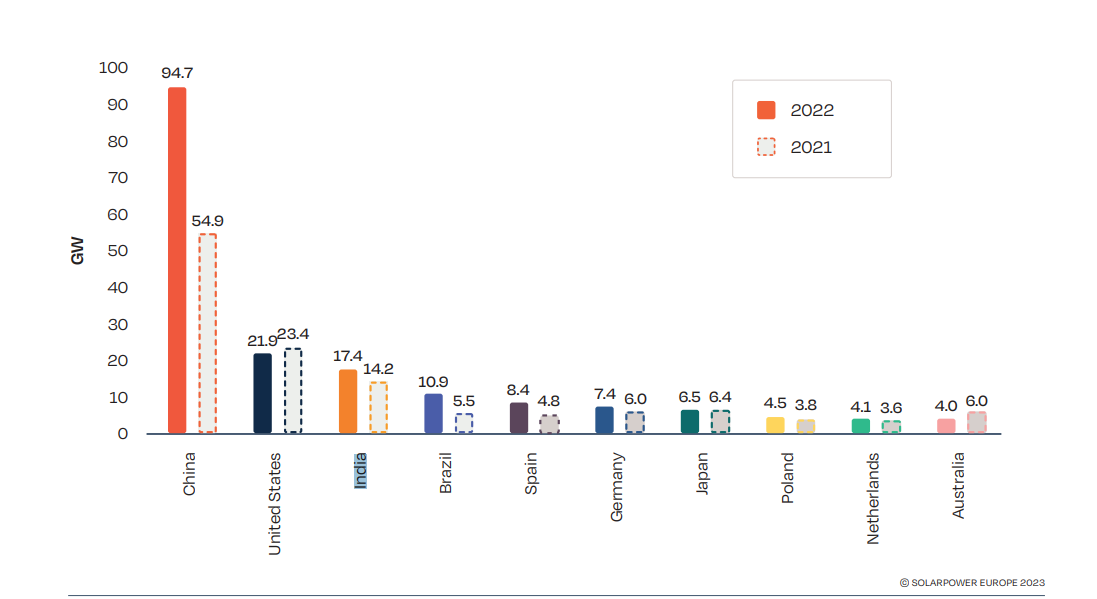The world installed 239 GW of new solar capacity in 2022, 45% up year-on-year. The total globally installed solar capacity reached almost 1.2 TW by the end of 2022, according to a new report by SolarPower Europe.
China continued to top in annual PV capacity addition by adding almost 100 GW in 2022—more than four times as much solar PV capacity as the second-largest market, the United States.
The US remained the second largest PV market in 2022, with 21.9 GW of annual addition.
India retained its third spot in annual PV capacity addition by installing an impressive 17.4 GW solar capacity in 2022, 23% up from 14.2 GW in 2021. Rooftop solar accounted for only 28% (4.9 GW) of annual installations in 2022.
The nation reached total PV installations of 77.6 GW (with 10 GW from rooftop) by the end of 2022, missing the 2022 target of 100 GW by a large margin. The analysts cite the dismal rooftop solar addition of 10 GW against the 40 GW target as the main reason for India falling significantly short of its 100 GW target.
The analysts anticipate a relatively slower PV growth in India in 2023, with around 20 GW of new capacity addition, representing a 15% growth compared to the previous year’s 23%.
“The market keeps expanding, but it is important to consider India’s historical sensitivity to PV product prices. The implementation of a basic customs duty of 25% on solar cells and 40% on modules from April 1st 2022 may result in project delays. There were also little module imports from China in the first months of the year,” stated the report.
On the other hand, after missing the 100 GW target by 2022, the government is implementing various measures to reach its ambitious goal of 280 GW of solar PV by 2030. Accomplishing this target would require the annual market to experience rapid growth, averaging 25 GW per year between 2023 and 2030.
Under the medium scenario, the analysts predict that India will add 24.5 GW in 2024 and 28.4 GW in 2025, and up to 38.3 GW in 2027.
“While the utility-scale sector will continue to be the primary driver of solar growth in India, the distributed segment, which played the key role in falling short of the 2022 target, will transition away from its niche status in the medium to long-term,” they said in the report.
This content is protected by copyright and may not be reused. If you want to cooperate with us and would like to reuse some of our content, please contact: editors@pv-magazine.com.









By submitting this form you agree to pv magazine using your data for the purposes of publishing your comment.
Your personal data will only be disclosed or otherwise transmitted to third parties for the purposes of spam filtering or if this is necessary for technical maintenance of the website. Any other transfer to third parties will not take place unless this is justified on the basis of applicable data protection regulations or if pv magazine is legally obliged to do so.
You may revoke this consent at any time with effect for the future, in which case your personal data will be deleted immediately. Otherwise, your data will be deleted if pv magazine has processed your request or the purpose of data storage is fulfilled.
Further information on data privacy can be found in our Data Protection Policy.